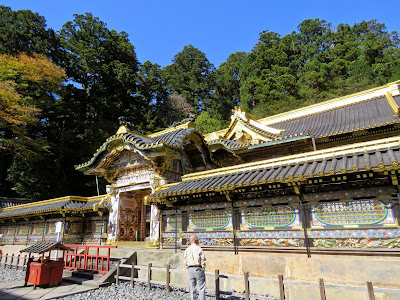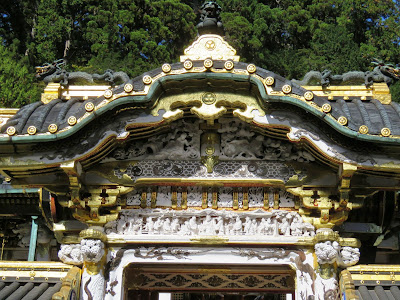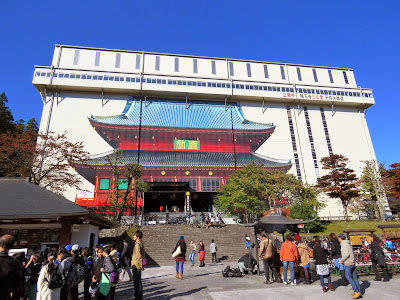
Toshogu Shrine is the most significant temple among The Shrines and Temples of Nikko World Heritage Sites. Its Grand Yomeimon Gate with intricate decorations and awesome architectural features is the most ornate structure at site. It is a national treasure and a master piece of structure in Nikko. During our time of visit, it was covered up by scaffolding to go through stages of major repairs and renovations. As from the illustrations, we can see that the entire gate was elaborately decorated with more than 500 sculptures of dragons, lions, elephants, phoenix and many other imagination animals. Numerous human characters are extracted from Chinese legends and lives of Japan. Yomeimon is sometimes nicknamed as "Twilight Gate" as one needs a day to go through its detailed carving contents.


Toshogu Shrine built in year 1617, is the final resting place of the founder of Tokugawa Shogunate that ruled Japan for 250 years until 1868. It was initially a relatively simple mausoleum for Tokugawa Ieyasu (1543-1616) but renovated and expanded to the present scheme by his grandson Lemitsu in the first half of 1600s. More than a dozen buildings were built and set in a beautiful forest on mountainous slopes with grove of Japanese cedars planted around. The entire Shrine complex was lavishly decorated with uncountable wood carvings and large amount of gold leaf. The deified spirit of Ieyasu was moved back from its original place at Mt Kuno to Nikko Toshugu Shrine 20 years after his death when the buildings were completed in year 1636.


Toshogu Shrine Complex was gilded with 2.4 million sheets of gold leaf, which were more than enough to cover 6 acres of land. Number of labors involved was as up to 4.5 million including artisans and craftsman. The group of elaborately adorned shrine buildings were set in grove of ancient Japanese cedars (trees) widely planted by man force. The sign of wealth and power of Takugawa Shogunate had left an exquisite heritage to the nation. It is one and the only one in Japan.


The Main Shrine building is a master piece of remarkable and grand architectural art. It lies behind Yomeimon Gate and enclosed by a stretch of roofed walls with lattice windows and reliefs panels. The richly detailed ornamented structure contains two separated halls connected by a stone chamber at the back. The Worship Hall houses three deified images of Japan most influencing historical personals. Tokugawa Ieyasu certainly was one of them. The other two are Minamoto Yoritomo (1192-1333), The Founder of first Shogun and General Toyotomi Hideyoshi (1536-1598) who ended the Warring States of Sengoku and unified Japan.


Toshogu Shrine defines the characters of Japanese Shrines and mausoleums. Its mesmerizing complex and architectures has great influences in the designs and styles of building Japanese shrines and mausoleums there after.



The exterior part of Tozai Kairo roofed colonnade that enclosed in the upper level shrines, contains amazing designs of lively wildlife and some other symbolism. The sculptures were colorfully painted with ultraviolet and weather resistant oil paint using a secret technique invented by Painter Kano Tanyu (1602-1674). It was said that such technique was lost during Meiji period (1868-1912)


Leading to The Main Shrine Buildings is another national treasure of Japan, Karamon Gate.


Karamon Gate is painted in white with 27 characters depicting the story of seven sages of Bamboo Grove, happened in the history of China during Three Kingdom period (240-249).



The set up style and decorations of Toshogu Shrines were much influenced by Chinese factors than Japanese, specially reflected in its carvings.



The elegant Shinyosha Hall houses three sacred Mikoshi Palanquins that used to carry the deities to Futarasan Shrine during the 1000-persons procession in Togyosai May Festival on 17th and 18th every year. The central and the right Mikoshi with a phoenix mounted on its roof, are the carriers for deified spirit of Tokugawa Ieyasu and Toyotomi Hideyoshi. The left one is for spiritual deity of Minamoto Yoritomo, founder of first Shogun. Each Mikoshi weighs 800 kg and required 55 persons to carry it in the procession. The ceiling of Shinyosha is painted with Tennyo, the heavenly musical Devas and flying Apsaras, by the famous artist Kano Tanyu in 1620s.



The Gate on the right side of Main Shrine Hall is called Sakashitamon Gate. Its transom bears the Famous carving of Nemuri Neko Sleeping Cat in front and pair of Sparrows on the reverse side of it. Long flight of stone steps leading uphill through woods of cedars trees to the inner shrine and tomb of Tokugawa Ieyasu begins from here.



Illustrations and pictures displayed at the side hall provides a detailed information about this elaborately decorated structure of Yomeimon Gate in Toshogu Shrine Complex.



Barrels of Sake donated to the Shrine are stacked up in Kairo corners near its administrative office.



Bell and drum pavilions.


Friendly Japanese "Obasan' (Elderly ladies)



The 25 carved panels of nature scenes at the southern part of Tozai Kairo, similarly were painted by the lost technique invented by artist Kano Tanyu in 17th century. The mixture of 7 colors applied in 35 steps of process made the paintings remain vibrant and resistant to ultraviolet light, water and weather for long period.



The huge Cedars standing high next to the castle-like Pavilion, along the pathway to Honjido (Yakushido) Medicine Buddha Hall was one of the original ancient trees planted in 17th century. Honjido is famous for its Nakiryu Roaring Dragon. When the monk strikes his wooden clappers directly under the head of the dragon painted on the ceiling of the hall, echo produced resonates like a bell. Display inside the Hall are twelve statues of Chinese Zodiac characters.



Beautiful Kyozo Pavilion is a hall for keeping sacred Sutra.


Each of the buildings at site has intricate and ornate details including this little lovely Purifying Omizuya pavilion where pilgrims cleanse their hands and mouth before entering the Shrine Halls.


Place to hang your written wishes that you want them to come true. The first bronze Tori Gate of Japan stands just within the space of this with The Purifying Omizuya pavilion. (I forgot to take a full picture of it).


Shinkyo, the only unpainted bare wood structure at site, is a stable for sacred horses dedicated to Shinto Gods. It was built in year 1636 in the home styled design of feudal lords.



It was believed that monkeys protect horses and had been kept in stable as guardian until Muromachi period (1336-1573). The monkeys carved at the exterior wall of Shinkyo wooden building most probably serves this purpose. It is interesting to observe the different actions of those monkeys carved in various panels. It begins with two monkeys of Son and Mother, Three monkeys of no Evils, Independent monkeys, Monkeys of ambitions, Monkeys in Social, Monkeys in love, Married Monkeys and Pregnant monkeys. It depicts a complete life cycle of monkeys in correspondence to all of us. Among all, the three monkeys of "See No Evils, Hear No Evils and Speak No Evils" is the most exquisite and received most attentions.


The group of colorful buildings standing adjacent to the wooden stable are the store houses. There are three of them. The buildings are used for the storage of the costumes and all relevant equipments required for the 1000-persons Samurai styled procession when spiritual deities of Japanese three heroes are carried in the Mikoshi to Futarasan Shrine. The structures were built with raising floors and have heavy supportive posts, with architectural style designed as Azekura-Zukuri Shrine of Todaiji Temple of Nara.


The site of colorful and decorative storehouses are the most favorable place for groups to take photographs. Herds of young students come in contact and listen to an interesting lessen of the history, the architecture and the arts closely associated in 16th to 17th century. The memorial moment was marked with a snap with classmates and teachers.



The elaborate carvings at the external roof eaves of Kamijinko Store House include the two renowned sculptures of Imaginary Elephants in its absurd look. The images were created by Kano Tanyu who learn about the animal from book but had never seen the actual one before.


The Omotemon Front Gate was known as Nio-men in the past as it had two Japanese Guardian Gods Nio Ungyoh and Nio Agyoh on its left and right. The current name was applied in Meiji era (1868-1890) when Government enforced to have Buddhism factors separated from Shinto shrines and when two guardian gods were moved out to else place. Images of Nio were relocated back in year 1897. Standing together with gate are few huge ancient trees called Cedars. It is The National Tree of Japan.


The 35 meter tall pretty five tiers Pagoda standing in front of the main entrance gate has a history of near 400 years. According to information, the original one was contributed and built in year 1650 by Sakai Tadaksatsu, a local land Governor. In year 1815, it was burnt down but immediately restored 3 years later by Sakai's descendants. Pagoda was built with a main pillar suspended 10 cm from the ground by a chain to stabilize the building from earthquake as well as to overcome the shrinkage and expansion of the wood material. We were told that there is an image of Buddha Vairocana enshrined at its first level but only opened in certain period for public to pay homage.



The three characters carved on the stone is the name of the Toshogu Shrine which means Palace of Easting Shinning Light. The bronze lanterns carved with designs are lovely.


Crowds of people non-stopping flocking in to this religious site that composed more than 100 halls of two ancient Shinto shrines and one old Buddhist Temple.


A view of Nikko Mountain.


The 9 meters tall stone Tori Gate built with 15 pieces of granite is the largest from Edo Period (1603-1868).


Stone lanterns offered by feudal lords from all places over the country, line up the pathway leading to the precincts of Futarasan-jinja Shrine in the south entrance. Complex of Futarasan-jinja lying about 200 meters away from the lavished Toshogu Shrine, is part of Nikko Shrines and Temples included into Unesco World Heritage Site. Several of its buildings and cultural artifacts had listed as important cultural assets of Japan.


Futarasan-jinja dedicating to Gods of sacred mountains surrounding Nikko, was founded in year 782 by Buddhist Priest Rev. Shodo Shonin. The site is nestled amidst in a serene surroundings with woods of old trees. There are various little halls worship with God of fortune, happiness and good marriage. Paper charms are tied around Trees growing in pair as it is a sign of lovely couple and at trees in triple as it represents happy family.



Futarasan is another name for Mt Nantai. The three deities of Mt Nantai, Mt Nyoho and Mt Taro, enshrined in the Main shrine hall are Okuninushi, Tagorihime, and Ajisukitakahikone.


At the open space between the flight of entry steps and shrine hall, there is a bamboo circle loop tied inside a square frame, hanged with many folded papers. It must be a sacred spot to place the wishes.



Nikko is very famous for its Yuba Meal. Yuba are thin film rising up from the surface of the boiling soya bean which we normally address them as bean curd skin. Before Meiji period in 19th-20th century, only Imperial family, monks or priests were allowed to take such kind of high protein by-products. The vegetarian set we took for our lunch at the nearby restaurant though simple and tasted not really great, it fills up our stomach comfortably, give us energy to continue our exploration in this sacred mountainous religious site.



Down the slope of the mountains from Toshogu Shrine nested on a hillside, is Nikko most import Buddhist Temple Complex of Rinnoji. It is reputable for the three huge gold lacquered Buddha Images, its 200 years old Edo period typical landscape garden Shoyo-en and its Treasure House that houses large amount of relics that have to be displayed on a rotating basic.


Rinnoji is the general name applied to its 15 sub-temples. There is no building named after this. Rinnoji was founded by a Buddhist monk Rev. Shodo Shonin in 8th century. After he built the first temple named as Shihonryuji near Shinkyo sacred bridge in year 766, Nikko began to become a popular retreat site for ascetic monks to meditate in the mountain. The site was once having as many as 500 sub-temples ruled by Rev. Shodo.



Rinnoji Complex was reconstructed and relocated several times. The present premises were built in year 1647 and relocated to the current site in year 1879 when the separation policy of Buddhism from Shintoism was implemented by Meiji Government (1868-1912).


Futatsudo are the two training Halls linked by a corridor within Rinnoji Complex. The Japanese styled Joyyo Hall was formerly used by ascetics to practice walking medication while reciting Amitaba Sutra. Hokke-do which followed the building style of Chinese Temple, was the repentant hall where devotees made confessions and prayers.


The Three Buddha Hall Sanbutsudo is the main Shrine Hall of Rinnoji Complex, where people pray for world peace. The hall which is also known as Hondo, is famous for its three 8m tall gold lacquered wooden images of Buddha . The images represent more to Gods of three Nikko mountains rather than The Lord Buddha. Senjukannon is Goddess of Mercy in thousand hands but it refers to Mt Nantai here. Batokannon is also Goddess of Mercy but appears with horse head. It refers to Mt Taro and Buddha Amidanyorai stands for Mt Nyoho. Most of the structures in Rinnoji are currently undergoing a ten years renovation and restoration project and expected to complete in year 2021.


The brass statue of Rev. Shodo Shonin, a great Buddhist monk who introduced Buddhism to Nikko in 8th century.


No comments:
Post a Comment